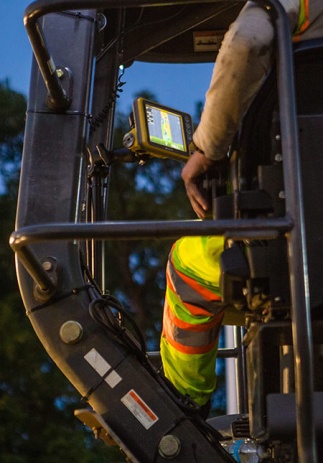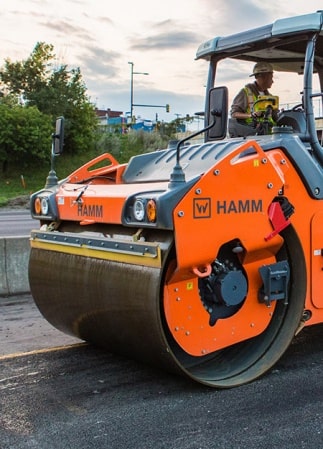Get Smart
Intelligent Compaction is the order of the day on Minneapolis paving project.

As anyone actively involved in the asphalt paving business would know, the state of Minnesota has been at the forefront of a federal push toward the use of Intelligent Compaction (IC) for some time now. The state has, in fact, been testing IC in aggregate applications as far back as 2004. It should come as no surprise then, that when a major section of Interstate 94, the primary artery into and out of downtown Minneapolis, was slated for resurfacing in advance of the city hosting the big game in 2018, IC would play a major role in the project. For Valley Paving, Inc., the local firm heading up the resurfacing effort, employing the technology not only fit well with their progressive company philosophy, it also helped ensure that critical performance-based paving criteria were consistently being met on this high-profile project.

"Our first go-around with IC was in 2011, when we outfitted four rollers with systems from a different manufacturer...This time, however,
it’s a whole new ballgame."

Willing Participant
One of Minnesota’s largest general contractors, Shakopee, Minnesota-based Valley Paving, Inc. has met the area’s needs for nearly four decades, providing a range of services that, in addition to asphalt paving, includes milling, reclaiming, utility pipe work, excavation and grading. According to Brent Carron, company vice president and son of founder Richard Carron, following in his father’s footsteps was never in doubt — at least from his own perspective.
“I’ve been tagging along with my dad to his jobsites ever since I was a kid and, at age 15, started working summers with the company,” he said. “But, because parents always want better for their children, they did not want me to get into the paving business and insisted I go to college. So I got a degree in construction management from Purdue University, then came back to the business. Truth is, I like building things and this is the type of industry in which you can look back at the end of the day and see that you’ve accomplished something — that’s not always possible in a lot of career fields.”
The current project which Carron is pondering at the close of each day involves 5 ½ miles of five-lane paving — in both the east and westbound directions — on I-94, the most heavily-traveled road in the Minneapolis metro area. The project started in May and, by its end in early Fall, will have seen more than 110,000 tons of asphalt and bonding material laid down.
Massive Cover-up
Performed in both nighttime and daylight pours, under full-closure and partial lane restricted situations, the I-94 project called for a 2-inch overlay of asphalt on the artery that will carry most traffic into and out of US Bank Stadium, the site of this year’s big game. The $46 million project ($8.5 million in asphalt alone) started with placement of a 5/8-inch wearing coarse (NovaChip).
“Because the original surface is concrete, that NovaChip acts as a bond breaker,” said Carron. “The concrete was in relatively poor condition and this ultra thin bonded wearing coarse is helping as we put the single 2-inch lift of hot mix asphalt over the top. We are using two Roadtec pavers: a Model 195 and a Model 175, each one outfitted with a MOBA infrared scanner to identify any temperature segregation in the mix. It is believed that having a consistent mix temperature will result in consistent compaction, since cold spots tend to compact differently.”
And if anyone knows compaction it is MNDOT. The department has been championing IC technology almost since its inception and is increasingly demanding employment of it from asphalt subcontractors. For Valley Asphalt, bringing IC to bear was something of a déjà vu moment, said Carron.
“Our first go-around with IC was in 2011, when we outfitted four rollers with systems from a different manufacturer,” he said. “MNDOT wanted to start getting into the technology so they more or less subsidized it for us. We used it on one project, the results were less than what was expected, and we didn’t use it again — until this year. This time, however, it’s a whole new ballgame.”
IC? I See!
Taking a step back, it might be best to offer a look at just what constitutes an Intelligent Compaction approach to paving. IC generally refers to the compaction of road materials — soils, aggregate bases, or asphalt pavement materials — using modern vibratory rollers equipped with specialty components. These can include: an integrated measurement system, an onboard computer reporting system, GNSS-based mapping, and, perhaps, a feedback capability. By integrating the measurement, documentation, and control systems, a company’s IC-equipped rollers can bring about real-time compaction monitoring and allow timely adjustments to the compaction process — key to minimizing the risk of over- or under-compacting the asphalt.
According to Carron, the IC approach taken for the I-94 project is far more sophisticated than the one undertaken in 2011. “One of the main benefits of IC is an ability to gather massive amounts of data in real-time and upload it for immediate analysis and evaluation,” he said. “The system we tried back then wasn’t even cloud-based. The solution we are now using, the C-63 Intelligent Compaction System from Topcon, uses an in-cab monitor to show our operators exactly where they’ve been, how many passes they’ve made, temperature and stiffness factors, and more. As a company, we pride ourselves in providing a quality product and this just reconfirms that for us.”

"Just being able to look at a screen and verify how many passes they’ve made —ensuring they are getting good coverage all the way through — is huge."

Save My Place
IC’s ability to help a roller operator determine where he or she started and stopped is an important benefit, according to proponents of the technology. Though that wasn’t critical, given the urban setting of I-94, in which power poles, bridges, and other landmarks can be used to help determine position, other facets of the solution were invaluable, said Carron.
“Just being able to look at a screen and verify how many passes they’ve made —ensuring they are getting good coverage all the way through — is huge,” he said. “An operator can lose track of the pass count and end up over-rolling an area. On this project, we are doing a five-pass pattern: up/back, up/back and then up again. A miscount can easily lead to a seven-pass pattern which not only over-rolls the material, it also impacts production, since the pavers have to slow down to compensate for the longer rolling time. That risk is eliminated with this system. The operator knows — at all times — exactly how many passes he has made.”
Carron added that consistent pavement stiffness is yet another area which benefits from the use of IC. Generally, operators are dependent upon both the “feel” of the roller on the asphalt and the sound of the drum’s vibrations in determining whether they are getting the densities they need or if additional compaction is needed. Now, simply by applying the system’s stiffness calculation function, they have a quantifiable measurement of pavement stiffness.
“That is really what it’s all about,” said Carron. “The ability for our roller crews to have info at their fingertips confirming what they’ve always had to trust to their judgement or memory. And that, in turn, helps ensure that we are providing MNDOT with the high-quality product they expect from us.”
Multi-Layer Support
At the I-94 project, Valley Paving used a fleet of seven IC-equipped vibratory rollers working behind the pair of Roadtec pavers to lay down 2 ½ inches of asphalt that will compact to a 2-inch mat. According to Carron, that many rollers, all running a sophisticated compaction system, could have been a real challenge were it not for the level of support they’ve received.
“The assistance we’ve gotten from both Topcon and RDO Integrated Controls, the area Topcon dealer, has been outstanding,” he said. “In addition to the strides Topcon has made in the technology, the support was one of the biggest reasons why we went with them and not their competition this go-around. We knew that having seven rollers on a high-profile project like this would involve a good deal of service, training and ongoing help — and we’ve gotten that. The RDO team has been out here whenever we requested help, and both companies had people help us as we first tackled the critical data transfer facet of the job. Keep in mind that, once we get the info, we have to take it from Topcon’s C-63 system and roll it into MNDOT’s Veta software, and any time you do that, you run the risk of losing data. So having people like RDO’s Blair Scheibel and Dan Wiese work with us was a huge help.”
That level of support is aided by an ability to remotely log in and view the progress of any of the rollers via the Topcon Sitelink3D solution. Designed to provide remote connectivity with machines at the jobsite, Sitelink3D has allowed both Valley Paving supervisors and any support/service personnel to monitor the progress of each roller at work on the I-94 job.
“We had some issues early on and Blair and Dan were able to get online and zero in on one of these units to see what is going on,” said Carron. Using Sitelink3D, they can look at the color-coded passes indicated and identify areas that were missed, spot any low density areas — info that could, in turn, tell us whether we have too many, or too few, trucks onsite. Much of the work out here was done at night which is not the most convenient time for a service call, but that remote capability suddenly makes it a lot easier to resolve things.”
Smart Sites
MNDOT’s push toward the use of IC makes perfect sense, given the much broader emphasis on what’s been called intelligent construction technology occurring across the international construction spectrum. Topcon itself calls such an approach: the intersection of infrastructure and technology — that is, the point at which industry professionals have the necessary solutions at their disposal to meet the demands of today’s projects. While intelligent construction currently centers around IC and the paver-mounted thermal profiling Valley Paving had in use on I-94, it could arguably also include things like automated machine control, 3D modeling, Civil Integrated Management (CIM), Building Information Modeling (BIM), and more.
“There’s no doubt that MNDOT has been spearheading the use of IC and will continue to do so,” said Carron. “The department has more than $1 million invested in the software aspect of the technology alone, and has already made it clear that all its projects for the 2018 paving season will be IC-mandated projects. And their support for IC has already shown a trickle-down effect here in the metro area as Washington and Dakota Counties are themselves starting to roll out some of this technology. Eventually it will be on all jobs — and deservedly so. With IC, it is all about quality and quality yields longevity. The longer they can make these surfaces last, the less they have to invest in reconstruction. It’s a smart move from so many perspectives and we are happy to be on the cutting edge of its implementation.”

